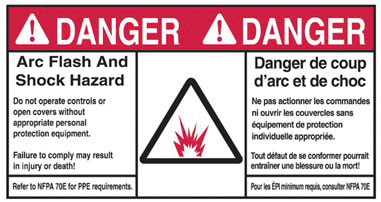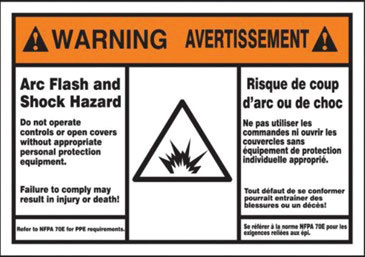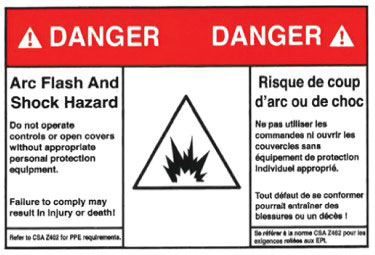The two official languages in Canada are English and French. This means that electrical products destined for the Canadian market must bear both English and French Danger, Warning, and Caution markings. The Canadian Electrical Code C22.1-21 Rule 2-024 requires electrical products to be approved. A product that is either factory-certified or field-approved is also required to comply with the general requirements of CSA C22.2 No. 0 Clause 6.3, which stipulates that all markings must be bilingual. The purpose of this article is not to highlight the requirements of the codes and standards but to help readers find the necessary translation tools for the proper choice of words.
For equipment manufactured for use in the United States, ANSI/NEMA Z535-4-2011- Product Safety Signs and Labels must be consulted before beginning the translation process. Table B1 gives a list of 17 different languages for the three signal words: Danger-Warning-Caution. Once the artwork, the sizing, colors, and pictograms have been established, translating the textual content may begin. You can either have a separate label or both languages on the same label if spacing allows it. For equipment manufactured for use in Canada, CSA Z462:21 – Workplace Electrical Safety and CSA Z321-Signs and Symbols for the Workplace will be used as a guide for mandatory markings, colors, and pictograms. Sadly, few of these standards offer direct translations with correspondence tables, so it’s up to you to do the necessary homework. One trick is to purchase the French edition of the Canadian Electrical Code C22.1:F21 and study the list of definitions. However, unless you are 100% bilingual, this may be a daunting task. There is also the French edition of the model code for field evaluation of electrical equipment SPE-1000:F21. Again, without a basic understanding of the French language, this may be a difficult read. Finally, many of the product standards are offered in French under the CSA C22.2 series or UL standards with the suffix (F). By using the official terms described in the code, no one will be able to say that your markings are invalid.
If the official terms are not present in any code or standard, this is where you would consider advice from a professional prior to sending it to the printing press. The tough part with the French language is that words are generally longer and may have different meanings. Therefore, if an internet site is used, the actual definition must be considered before considering it for your custom label. A free reputable internet site is offered in Quebec called Vitrine Lingustique; let’s see what it reveals for the term: “Arc / Flash.” If you type it in a search engine: https://vitrinelinguistique.oqlf.gouv.qc.ca/, four results appear, two of which apply to our case.
1-Éclat d’arc FR Électrique → Arc flash EN Électricité sécurité
Analysis: The result gives the English correspondence with the prefix EN. It then described the application as “Electrical Safety.” This is the correct term for the intended message because the description refers to molten material that is released following a fault current. The term ‘’Éclat’’ means ‘’spread of material’’. To verify your findings, you can type the French term in the search engine, and it will revert back to ‘’Arc / Flash’’ so we know that ‘’nothing got lost in translation’’ so to speak.
2- Coup d’arc FR → Welder’s flash EN- Médecine, sécurité, soudage
Analysis: This result refers to the actual impact from the electrical fault. The term “coup” means “being hit.” This term would also be acceptable for a warning marking because we are trying to warn the service or maintenance personnel that he / she could be struck if a dead short was to occur with the panel open while still energized.
3-Coup d’arc FR → Stay flash EN –
Analysis: We see that they are describing a flash of the welding process, which is not the message we are trying to convey.
4-Tension d’arc FR → Flash off voltage EN
Analysis: We see that they are describing the voltage of the arc, which is not the message we are trying to convey.
Below are three examples of Arc /Flash labels that are readily available on the market. Keep in mind that the textual content and standard references must be considered based on end users’ jurisdiction.



Field evaluation of unapproved electrical equipment can be a challenging exercise. Model code SPE-1000-21 addresses the essential construction, marking, and test requirements that equipment must meet before it is labeled in Canada. Proper nameplates, caution, and warning markings play an active role in mitigating risks associated with electrical equipment. Hazards may stem from a variety of different sources such as pressures, moving parts, energy, fire, shock, mechanical, radiation, and many more. Having the necessary visual aids is an integral part of the conformity assessment and can not be overlooked. Keep in mind that equipment operators will assume that their machinery is inherently safe. Therefore, appropriate verbiage and graphical symbols will help them make educated decisions before conducting human-to-machine interventions. The following page is a list of common electrical safety terms with a French translation: stay safe & soyez sécuritaire!
















Find Us on Socials